seats CITROEN DISPATCH SPACETOURER DAG 2020 Handbook (in English)
[x] Cancel search | Manufacturer: CITROEN, Model Year: 2020, Model line: DISPATCH SPACETOURER DAG, Model: CITROEN DISPATCH SPACETOURER DAG 2020Pages: 324, PDF Size: 10.89 MB
Page 4 of 324
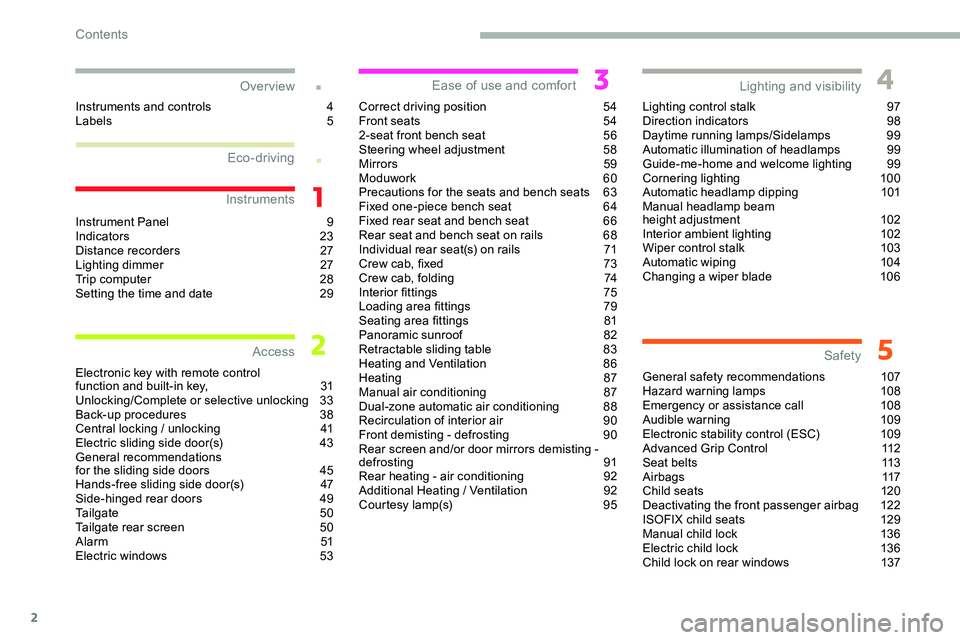
2
.
.
Instrument Panel 9
I ndicators 23
Distance recorders
2
7
Lighting dimmer
2
7
Trip computer
2
8
Setting the time and date
2
9
Electronic key with remote control
function and built-in key,
3
1
Unlocking/Complete or selective unlocking
3
3
Back-up procedures
3
8
Central locking
/ unlocking
4
1
Electric sliding side door(s)
4
3
General recommendations
for the sliding side doors
4
5
Hands-free sliding side door(s)
4
7
Side-hinged rear doors
4
9
Tailgate
5
0
Tailgate rear screen
5
0
Alarm
51
Electric windows
5
3Correct driving position
5
4
Front seats
5
4
2-seat front bench seat
5
6
Steering wheel adjustment
5
8
Mirrors 59
Moduwork
6
0
Precautions for the seats and bench seats
6
3
Fixed one-piece bench seat 6 4
Fixed rear seat and bench seat 6 6
Rear seat and bench seat on rails 6 8
Individual rear seat(s) on rails
7
1
Crew cab, fixed
7
3
Crew cab, folding
7
4
Interior fittings
7
5
Loading area fittings
7
9
Seating area fittings
8
1
Panoramic sunroof
8
2
Retractable sliding table
8
3
Heating and Ventilation
8
6
Heating
87
Manual air conditioning
8
7
Dual-zone automatic air conditioning
8
8
Recirculation of interior air
9
0
Front demisting - defrosting
9
0
Rear screen and/or door mirrors demisting -
defrosting
91
Rear heating - air conditioning
9
2
Additional Heating
/ Ventilation
9
2
Courtesy lamp(s)
9
5Lighting control stalk
9
7
Direction indicators
9
8
Daytime running lamps/Sidelamps
9
9
Automatic illumination of headlamps
9
9
Guide-me-home and welcome lighting
9
9
Cornering lighting
1
00
Automatic headlamp dipping
1
01
Manual headlamp beam
height adjustment 1 02
Interior ambient lighting 1 02
Wiper control stalk
1
03
Automatic wiping
1
04
Changing a wiper blade
1
06
General safety recommendations
1
07
Hazard warning lamps
1
08
Emergency or assistance call
1
08
Audible warning
1
09
Electronic stability control (ESC)
1
09
Advanced Grip Control
1
12
Seat belts
1
13
Airbags
117
Child seats
1
20
Deactivating the front passenger airbag
1
22
ISOFIX child seats
1
29
Manual child lock
1
36
Electric child lock
1
36
Child lock on rear windows
1
37
Over view
Instruments
Access Ease of use and comfort
Safety
Lighting and visibility
Instruments and controls 4
L abels 5
Eco-driving
Contents
Page 8 of 324
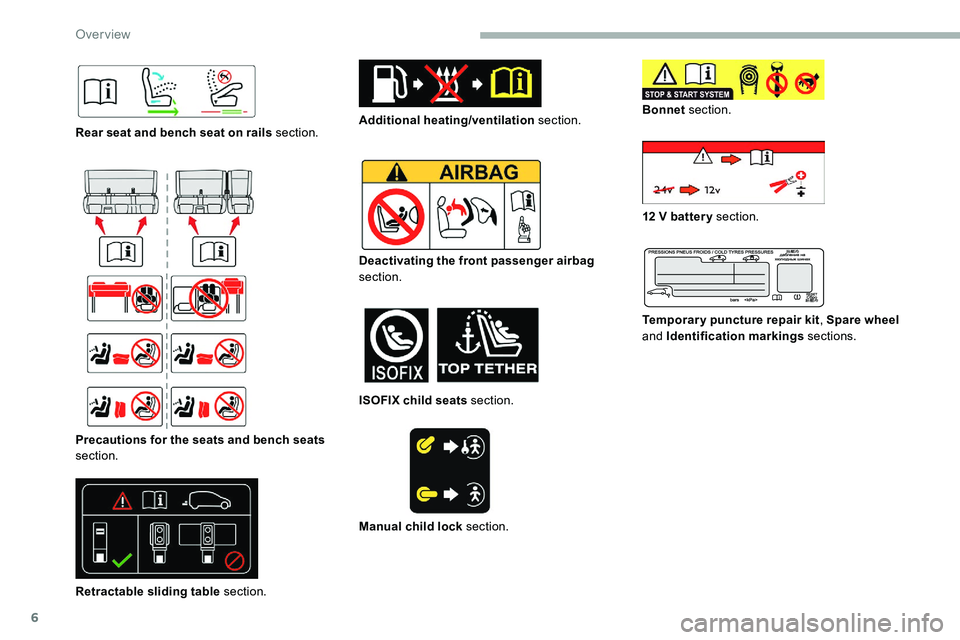
6
Rear seat and bench seat on rails section.
Precautions for the seats and bench seats
section.
Retractable sliding table section.Additional heating/ventilation
section.
Deactivating the front passenger airbag
section.
ISOFIX child seats section.
Manual child lock section. Bonnet
section.
12 V batter y section.
Temporary puncture repair kit , Spare wheel
and Identification markings sections.
Over view
Page 10 of 324
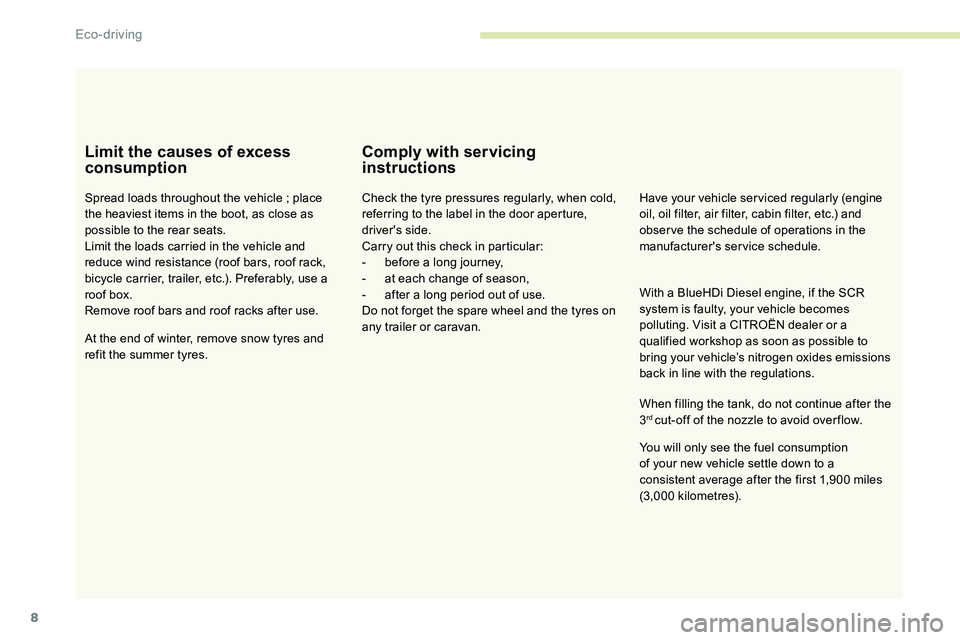
8
Limit the causes of excess
consumption
Spread loads throughout the vehicle ; place
t he heaviest items in the boot, as close as
possible to the rear seats.
Limit the loads carried in the vehicle and
reduce wind resistance (roof bars, roof rack,
bicycle carrier, trailer, etc.). Preferably, use a
roof box.
Remove roof bars and roof racks after use.
At the end of winter, remove snow tyres and
refit the summer tyres.
Comply with servicing
instructions
Check the tyre pressures regularly, when cold,
referring to the label in the door aperture,
driver's side.
Carry out this check in particular:
-
b
efore a long journey,
-
a
t each change of season,
-
a
fter a long period out of use.
Do not forget the spare wheel and the tyres on
any trailer or caravan. Have your vehicle ser viced regularly (engine
oil, oil filter, air filter, cabin filter, etc.) and
obser ve the schedule of operations in the
manufacturer's service schedule.
When filling the tank, do not continue after the
3
rd cut-off of the nozzle to avoid over flow.
You will only see the fuel consumption
of your new vehicle settle down to a
consistent average after the first 1,900
miles
(3,000
kilometres).
With a BlueHDi Diesel engine, if the SCR
system is faulty, your vehicle becomes
polluting. Visit a CITROËN dealer or a
qualified workshop as soon as possible to
bring your vehicle’s nitrogen oxides emissions
back in line with the regulations.
Eco-driving
Page 56 of 324
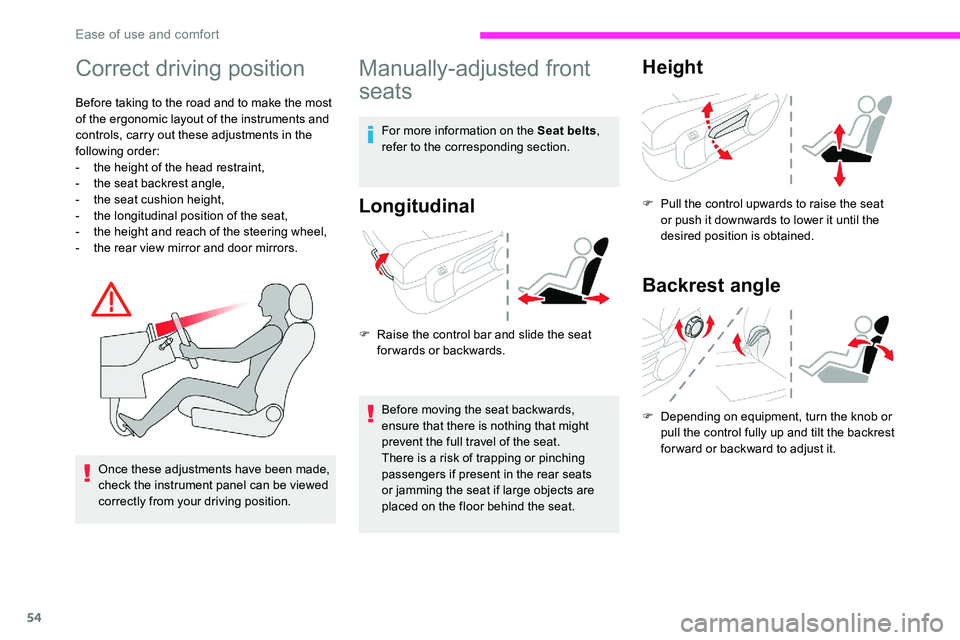
54
Correct driving position
Before taking to the road and to make the most
of the ergonomic layout of the instruments and
controls, carry out these adjustments in the
following order:
-
t
he height of the head restraint,
-
t
he seat backrest angle,
-
t
he seat cushion height,
-
t
he longitudinal position of the seat,
-
t
he height and reach of the steering wheel,
-
t
he rear view mirror and door mirrors.
Once these adjustments have been made,
check the instrument panel can be viewed
correctly from your driving position.
Manually-adjusted front
seats
For more information on the Seat belts ,
refer to the corresponding section.
Longitudinal
F Raise the control bar and slide the seat forwards or backwards.
Before moving the seat backwards,
ensure that there is nothing that might
prevent the full travel of the seat.
There is a risk of trapping or pinching
passengers if present in the rear seats
or jamming the seat if large objects are
placed on the floor behind the seat.
Height
F Pull the control upwards to raise the seat or push it downwards to lower it until the
desired position is obtained.
Backrest angle
F Depending on equipment, turn the knob or pull the control fully up and tilt the backrest
forward or backward to adjust it.
Ease of use and comfort
Page 57 of 324
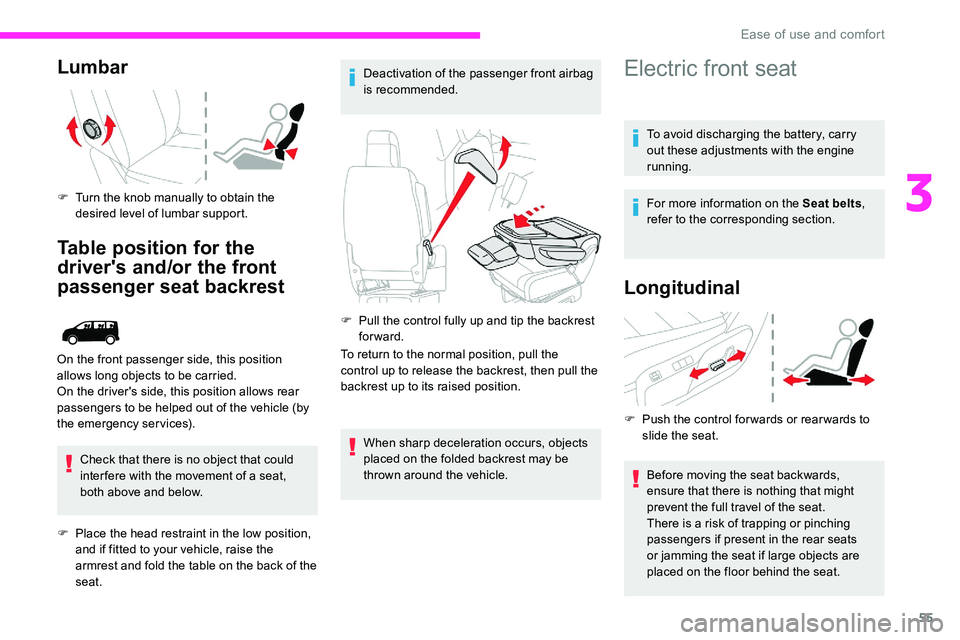
55
Lumbar
F Turn the knob manually to obtain the desired level of lumbar support.
Table position for the
driver's and/or the front
passenger seat backrest
Check that there is no object that could
inter fere with the movement of a seat,
both above and below.
F
P
lace the head restraint in the low position,
and if fitted to your vehicle, raise the
armrest and fold the table on the back of the
seat. Deactivation of the passenger front airbag
is recommended.
F
P
ull the control fully up and tip the backrest
forward.
To return to the normal position, pull the
control up to release the backrest, then pull the
backrest up to its raised position.
On the front passenger side, this position
allows long objects to be carried.
On the driver's side, this position allows rear
passengers to be helped out of the vehicle (by
the emergency services).
When sharp deceleration occurs, objects
placed on the folded backrest may be
thrown around the vehicle.
Electric front seat
To avoid discharging the battery, carry
out these adjustments with the engine
running.
For more information on the Seat belts,
refer to the corresponding section.
Longitudinal
F Push the control for wards or rear wards to slide the seat.
Before moving the seat backwards,
ensure that there is nothing that might
prevent the full travel of the seat.
There is a risk of trapping or pinching
passengers if present in the rear seats
or jamming the seat if large objects are
placed on the floor behind the seat.
3
Ease of use and comfort
Page 59 of 324

57
If the vehicle is so equipped, a storage space is
provided under the seat.
F
P
ull the strap towards you to tip the seat
cushion.
Armrest
The armrest has notches.
F
P
ull the armrest fully up
F
L
ower it fully down.
F
R
aise the armrest to the desired position.
Heated seat and bench
seat
If fitted to the vehicle.
F W ith the engine running, use the adjustment
wheel to switch on and select the desired
level of heating from 0
(off) to 3 (h i g h).Prolonged use of the heated seats is not
recommended for those with sensitive
skin.
There is a risk of burns for people whose
perception of heat is impaired (illness,
taking medication, etc.).
To keep the heated pad intact and to
prevent a short circuit:
-
d
o not place sharp or heavy objects on
the seat,
-
d
o not kneel or stand on the seat,
-
d
o not spill liquids onto the seat,
-
n
ever use the heating function if the
seat is wet.
Do not use the function when the seat is
not occupied.
Reduce the intensity of the heating as
soon as possible.
When the seat and passenger
compartment have reached an adequate
temperature, stop the function ; reducing
the consumption of electrical current
reduces fuel consumption.
3
Ease of use and comfort
Page 65 of 324

63
Removing the net
F Release the hooks from the rings 4 and 3.
F R emove the lower fastener 2 then the upper
fastener 1 , turning them by a quarter turn
backwards to unlock them.
Make sure that the size, shape and
volume of the loads carried are compatible
with the highway code and safety
regulations and do not impair the driver’s
field of vision.
All loads must be appropriately secured
to prevent or minimise displacement and
prevent injury.
Install the anti-slip net (supplied with the
vehicle) every time that the seat is raised
and the partition flap removed.
Never use the net for any other purposes.
Regularly check the condition of the
anti-slip net. As soon as signs of wear or
tear appear, contact a CITROËN dealer
to have it replaced by an anti-slip net
that meets the specifications required by
CITROËN for the vehicle.
Always fit the removable flap back into
place when you are not carrying any long
loads.
"Swivelling writing table"
If the vehicle is so equipped, the central seat
cushion of the bench seat can be tilted to form
a swivelling working table top, thus creating a
mobile desk (with the vehicle stationary).
F
P
ull the handle located at the top of the
backrest cushion.
Central seat cushion
storage
Never use the table while the vehicle is
moving.
Any object on the table will become a
dangerous projectile that could cause
injury in the event of sudden braking or
collision.
Precautions for the seats
and bench seats
Do not remove a head restraint without storing
it and securing it to a support.
Ensure that the passengers can always access
the seat belts and fasten them easily.
A passenger must not take their seat without
adjusting the seat's head restraint correctly and
adjusting and fastening their seat belt.
Ensure that no object or passenger feet
could obstruct the anchorage points
or prevent the correct latching of the
assembly.
3
Ease of use and comfort
Page 66 of 324

64
Loading luggage or objects
behind the row 3 seat and
bench seat
Fixed one-piece bench seat
The different levels of equipment and settings
described hereafter vary according to the
version and the configuration of the vehicle.
The bench seat has a one-piece backrest that
may be fixed or folding (table position).For more information on the Seat belts ,
refer to the corresponding section.
When driving, it is prohibited to have a
passenger:
-
i
n rows 2 and 3, in the outer right-hand
seat, if the bench seat is in the fully folded
position,
-
i
n the centre seat if the outer right-hand seat
is in the fully folded position,
-
i
n row 3 if the backrest in front (row 2) is in
the table position,
-
i
n row 3 if the seat /bench seat in front
(row
2) is in the fully folded position.
If you want to load luggage onto the backrests
in row 3 while in the table position, the
backrests in row 2 must also be in the table
position. If removing and storing seats and bench
seats out of the vehicle, ensure that they
are placed in a clean area, so as to avoid
introducing any foreign bodies into the
mechanisms.
The seats and bench seats are not
designed for any other use than in
the vehicle. They are equipped with
mechanisms and features that may be
damaged if used improperly or if dropped.
Ease of use and comfort
Page 73 of 324

71
Individual rear seat(s) on
rails
Shine, Business Lounge
The different levels of equipment and settings
described hereafter vary according to the
version and the configuration of the vehicle.
The individual seat is fitted with a three-point
inertia reel seat belt.
It can be placed facing forward or rearward
facing.
If there is a rear ward facing individual
seat in row 2, ensure that the seat in row
1
(driver or passenger) is not too far back,
in order to avoid contact between the two
seats.
This could cause significant wear of the
parts in contact. The backrest can be adjusted to several
positions.
Moving forward or
backward
Ar mrest(s)
The armrest has notches.
Adjusting the angle of the
backrest
F Pull the armrest fully
up.
F
L
ower it fully.
F
R
aise the armrest to
the desired notched
position.
For more information on the Seat belts
,
refer to the corresponding section. F
T
o recline the backrest, pull the control
upwards (from the rear, lower the handle).
F
R
elease the control when the desired
position is reached.
Two controls are provided for moving the seat
forward and backward:
F
F
rom the rear, pull the strap without going
beyond the point of resistance and push the
seat for ward or pull it backward.
F
F
rom the front, raise the control and slide
the seat for ward or backward.
3
Ease of use and comfort
Page 75 of 324

73
F Check that nothing is obstructing the rails.
F
F
it the front part on the rails.
F
T
ip the seat to align the rear of the guides in
the rails.
F
S
lide the seat for wards or backwards until it
engages in the notches.
F
Ra
ise the backrest.
Check that the seat has correctly locked
on the floor when returned to the seating
position.
Crew cab, fixed
It comprises a fixed bench seat, seat belts,
storage compartments (depending on
equipment) and side windows.
It is separated from the loading area by a high-
strength partition offering comfort and safety.
Rear bench seat
This ergonomic bench seat has three seats.
The two outer seats are fitted with ISOFIX
mountings.
For more information on the ISOFIX
mountings , refer to the corresponding
section.
Storage compartment Under seat cushion storage
wells
If the vehicle is so equipped, they are located
underneath the centre and outer left-hand
seats.
To gain access to it from the cab, tip the
required seat forwards.
If applicable, a storage compartment is
available at the front, underneath the bench
seat.
3
Ease of use and comfort